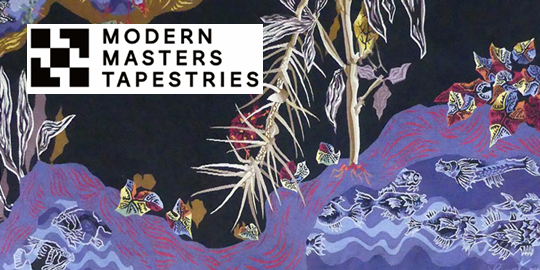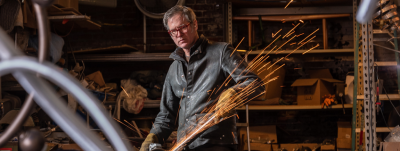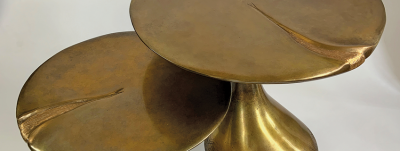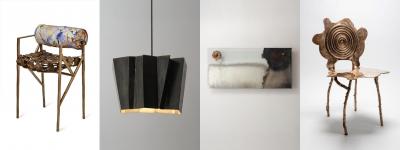Bill Traylor, Unfiltered
Antiques and the Arts Weekly - October 23 2009
Bill Traylor had an incredible visual imagination that did not become evident until late in life. Born a slave on the George Hartwell Traylor plantation in Benton, Ala., in 1856, Traylor took on the name of his master as did his parents, according to the 1900 census.
It is a mystery as to what could have motivated an 83-year-old man, born into slavery, who could not read or write, and had no training or exposure to art, to pick up an pencil and a straight-edged stick and start drawing figures on discarded cardboard in the spring of 1939. What is even more amazing is that, from that point, he almost never stopped drawing for the next three years, creating an incredible output of work, which is estimated at 1,200–1,600 pieces.
His routine was the same each day: after sleeping on a pallet among the caskets at the Ross Clayton Funeral Parlor in Montgomery, Ala., Bill Traylor situated himself on a box outside on Monroe Street, sandwiched in between a Coca-Cola dispensing machine and a pool hall. An imposing, bearded, heavyset man nearly six feet four inches tall, he maneuvered with two canes due to his rheumatism. Once seated, he pulled a crude board on his lap and started to draw, attracting spectators and children from his neighborhood.
His early drawings consisted of spare pencil silhouettes drawn with straight edges which he outlined and then filled in with pencil strokes. The images included rudimentary forms such as cups, shoes, small animals, geometric forms and perhaps the tools he had once worked with at a blacksmith shop.
Traylor attracted the attention of a young Caucasian artist, Charles Shannon, who recognized the power of his images and brought him better paper, pencils and poster paints. To this day, most first-hand information about Traylor's life and work comes from the dialogues he had with Charles SHannon on the street in Mongtomery. Frank Maresca and Roger Ricco's book, Bill Traylor, His Art — His Life1 constains much of this discourse between Shannon and Traylor, and allows us a glimpse into what might have motivated Traylor to pursue his storytelling through his art.
And tell stories he did! Many of his works appear to be influenced by visual memories of relationships between animals, men and animals, human interactions and domestic and religious gatherings. There are depictions of men drinking that convey a sense of abandon, especially in how the figures are almost whimsically animated on the paper, as if in a whirl of action. His subject matter included domestic disputes, chases, possum hunts, some nightmarish images and abstract constructions.
Traylor sold some of his drawings to Shannon, who tried to get others interested in Traylor's art. Other pieces were purchased by passerby. Traylor depicted both whites and blacks and he told Shannon how he distinguished between them. Placing his straight edged stick along the profiles of his drawn characters, Traylor said, "Now you see there, when the stick touches the nose and the chin but it doesn't touch the lips, it's a white man."2
Shannon mounted the artist's work at the New South gallery in Montgomery in 1940. In the program notes, he wrote, "Bill Traylor's works are completely uninfluenced by our Western culture. Strictly in the folk idiom — they are as unselfconscious and spontaneous as Negro spirituals. He has recorded the life he has known with a boundless imagination that is steeped in a real joy of living."3 Aside from that show, Traylor's work was not recognized during his lifetime, despite Shannon's efforts.
It was not until the landmark exhibit, "Black Folk Art in America" in 1982 at the Corcoran Gallery in Washington, D.C., that Traylor came to the attention of the art world. Thirty-six of his works were included in that exhibit and his sinuous snake graced the cover of the catalog.
We will never know what Traylor's motivations for his almost fanatical dedication to drawing were, but there is some indication that he thought people bought his paintings for specific reasons. Shannon remembers a comment Traylor made about how "sometimes they buys them when they don't even need them"4 There has been speculation that this indicates a power or purpose to the paintings, perhaps to conquer evils, or to dominate bad spirits, but much of this is unknown. Certainly many of Traylor's themes are socially charged and resonate with observers; whether or not these stories were depicted in order to right wrongs, justify behaviors, or mark a rebellious nature is all speculative. If, as suggested in a new book5 about Traylor, his hidden images are "conjure messages that were highly critical of the racist regime," this seems to be at odds with Shannon's firsthand perception of Traylor as a man with a joyous sense of life.
Certainly, however, the power of his images, constructions and stories reflects a singular understanding of the social order of the world as Traylor knew it, complete with emotion, wit and insight.
Today, Traylor is recognized as one of the most prolific, expressive artists of the Twentieth Century. He is called self-taught, visionary, outsider, primitive artist... among other things. But above all, he is viewed as an artist.
The above text is comprised of excepts from the book, Bill Traylor, Unfiltered, published by Just Folk, October 2009. The book is $45 and may be ordered from Just Folk. The exhibition, also titled, "Bill Traylor, Unfiltered" featured 28 works and was on view through December 9, 2009. Just Folk is at 2346 Lillie Avenue, Summerland, Calif. For information, call 805-969-7118 or visit www.justfolk.com.
2. Ibid
3. Montgomery (AL), New South Art Center, Bill Traylor — People's Artists, 1940
4. Maresca, Frank and Ricco, Roger, Bill Traylor, High Art — His Life, Alfred A. Knopf, New York 1991
5. Sobel, Mechel, Painting a Hidden Life: The Art of Bill Traylor, Louisiana State University Press 2009






























